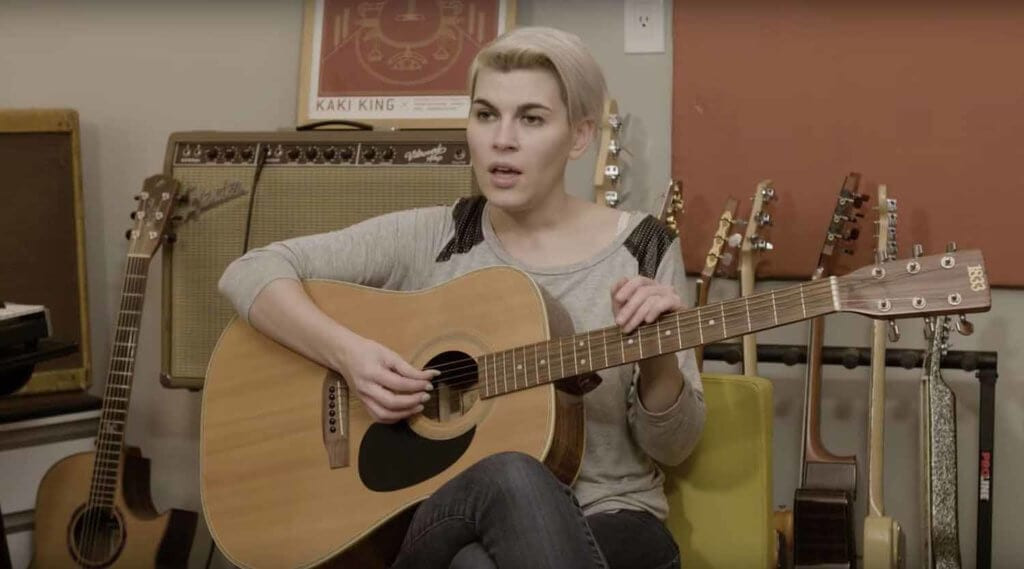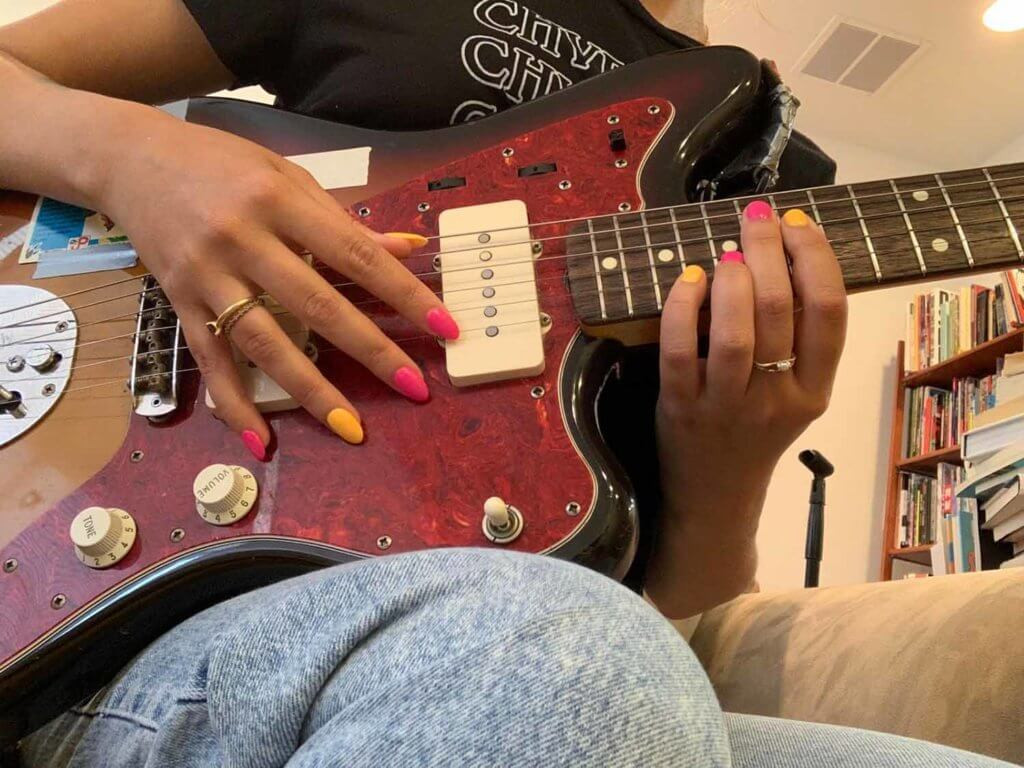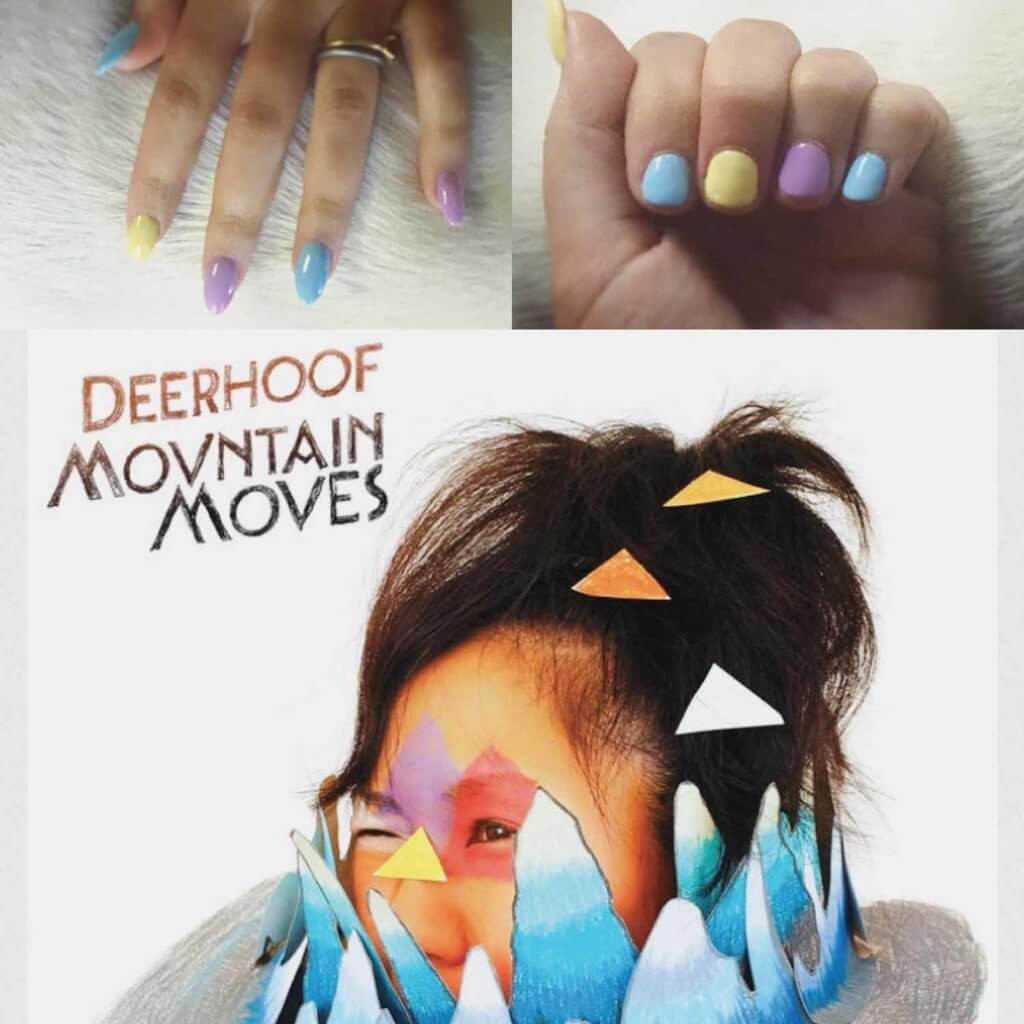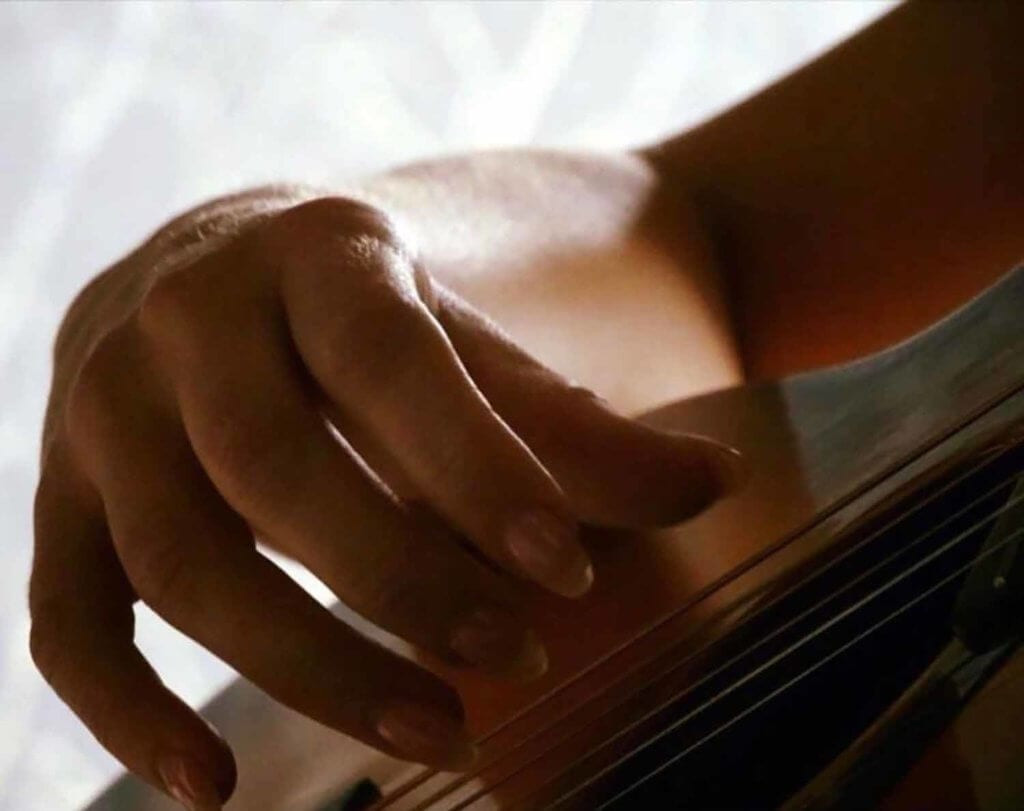For guitarists, the quest for perfect tone and effortless playability is unending. While we often focus on instruments, strings, and pedals, there’s an often-overlooked aspect that can dramatically impact your sound and technique: your nails. Specifically, guitar nails. This might sound like a purely cosmetic concern, but for many players, especially those embracing fingerstyle techniques, the condition and style of their nails are as crucial as any piece of gear.
In this comprehensive guide, we’ll delve into the world of Guitar Nails, exploring the benefits of a guitarist’s manicure, the various types of nail enhancements available, and how to shape and maintain your nails for optimal performance and personal style. Learn from experienced guitarists who have unlocked new sonic possibilities through nail care and discover how you can elevate your guitar playing with this often-secret weapon.
 Speedy Ortiz live at the Portland Pickles’ Picklefest, nails an homage to the minor league baseball team’s colors.
Speedy Ortiz live at the Portland Pickles’ Picklefest, nails an homage to the minor league baseball team’s colors.
Unlocking a New Sonic Dimension: Why Guitar Nails Matter
Many guitarists, like Sadie Dupuis of Speedy Ortiz, initially overlook the importance of nails. Dupuis, a versatile player known for blending fingerstyle, strumming, and shredding, realized the limitations of bare fingertips when transitioning between techniques on stage. “If I played with my bare fingertips just after playing leads with a plectrum, my guitar dropped in presence and clarity,” she explains. This realization led her to explore the world of “guitar nails” and the transformative impact they can have.
The core benefit of guitar nails lies in their ability to provide a consistent and articulate attack on the strings. Unlike the softer flesh of fingertips, nails offer a harder, more defined point of contact, resulting in:
- Increased Volume and Projection: Nails allow you to pluck strings with more force, generating a louder and more resonant sound, particularly beneficial in acoustic settings or live performances.
- Enhanced Clarity and Articulation: The crisp attack of nails produces a clearer, more defined tone, especially when playing intricate fingerstyle patterns or fast passages. Notes ring out with greater precision and less muddiness.
- Improved Control and Dynamics: Guitar nails offer greater control over your attack, allowing for a wider dynamic range, from delicate whispers to powerful pronouncements.
- Protection and Comfort: For players who experience nail breakage or discomfort when playing for extended periods, nail enhancements provide a protective layer, allowing for longer, more comfortable practice and performance sessions.
Expert Insights: Guitarists on the Power of Nails
The benefits of guitar nails are not just anecdotal; many accomplished guitarists swear by them. Folk multi-instrumentalist Johanna Warren credits acrylic nails for significantly expanding her compositional possibilities. Inspired by twelve-string virtuoso Alexander Turnquist, Warren adopted acrylics and describes the experience as transformative. “Getting acrylics opened up so many compositional possibilities and transformed my relationship to my guitar,” Warren states. “The nails let you get in there! You can get very specific about the timing and attack of every note, and play intricate rhythms with precision and power or lightly with a lot of nuance and delicacy.”
Etta Friedman of the band Momma, initially experimented with press-on nails seeking a melodic picking style reminiscent of artists like Rob Crow and Paul Simon. Switching to acrylics, Friedman was impressed by the protection they offered and the tonal improvement. “[Acrylics] have provided me with a less painful and a more tonally interesting way to play guitar,” Friedman notes. For Friedman, guitar nails are not just about sound but also about comfort and longevity in playing.
 Kaki King demonstrating her acrylics-informed playing during her master class video series, “Guitars & Things with Kaki King”
Kaki King demonstrating her acrylics-informed playing during her master class video series, “Guitars & Things with Kaki King”
Kaki King, renowned for her innovative and percussive guitar style incorporating fret tapping, highlights the need for a customized approach to guitar nails. Having played with acrylics for over 16 years, King emphasizes finding a “happy medium” to balance fingerpicking and tapping techniques. “You have to find that happy medium,” King advises. “My tapping will suffer because I don’t have as much direct downward perpendicular force [due to the acrylics]. I’ve learned to fingerpick with slightly shorter nails in order to allow the tapping to function.” King’s experience underscores the importance of tailoring your guitar nail style to your specific playing needs. She keeps her fretting hand nails bare and utilizes acrylics with extensions on her picking hand, excluding the pinky finger, demonstrating a nuanced approach to nail customization.
Navigating the Options: Types of Guitar Nail Manicures
For guitarists considering enhancing their nails, several popular options cater to different playing styles and nail conditions. Let’s explore three common types of guitar nail manicures:
1. Gel Manicures:
Gel manicures are a good starting point for players with naturally strong but shorter nails or those playing with lighter gauges. This method involves applying a gel-based polish cured under UV light, creating a thicker, more resilient layer.
- Pros: Gel manicures are the quickest and most affordable option, typically costing between $25-$50 and lasting around two weeks. They provide added strength and thickness to natural nails without significant extension.
- Cons: Gel manicures may not be durable enough for heavy playing or protecting longer nails. They offer less protection than acrylics or dip powder and are prone to wear and tear with intense playing.
2. Acrylic Nails:
Acrylics are a widely favored choice among fingerstyle guitarists, including Warren, Friedman, and King. This technique involves applying a liquid polymer and powder mixture to the natural nail or a plastic extension (tips).
- Pros: Acrylics are the most durable option, offering significant protection and allowing for substantial nail lengthening. They are ideal for players seeking maximum nail strength and projection. Acrylics can be sculpted to various shapes and thicknesses.
- Cons: Acrylic application can be more time-consuming and potentially damaging to the natural nail bed, often leaving ridges upon removal. Maintenance requires regular refills every 3-6 weeks, adding to the overall cost. King also cautions against thick gel topcoats on acrylics, as they can snag on strings. Initial sets range from $35-$65, with refills costing slightly less.
3. Dip Powder (SNS):
Dip powder, also known as SNS, is a popular alternative, favored by Sadie Dupuis. This method involves applying a gel base coat and then dipping nails into colored powder or sprinkling powder on top.
- Pros: Dip powder offers durability comparable to acrylics with potentially less damage to the natural nail. It generally requires less filing and doesn’t necessitate UV lamp curing. The colored powders eliminate the need for topcoats, reducing potential string snagging issues. Dip powder is considered a slightly healthier option compared to acrylics.
- Cons: Like acrylics, dip powder is not entirely “healthy” for nails. Removal involves soaking in acetone. Costs are similar to gel manicures, ranging from $30-$50, with polish removal required at each salon visit. While considered less damaging than acrylics, it’s still a chemical process.
 At home with a brand new manicure.
At home with a brand new manicure.
Shaping Your Sound: Nail Shape and Length for Guitarists
Once you’ve chosen a nail enhancement method, the next crucial step is determining the optimal shape and length for your guitar nails. Communication with your nail technician is key, and bringing visual references is always helpful.
Shape:
- Almond Shape: This shape, favored by Dupuis, Warren, King, and Friedman, mimics the natural curve of a guitar pick. It provides a balanced attack and is versatile for various playing styles.
- Stiletto Shape: Friedman is considering experimenting with stiletto nails, which are pointed and sharp, to emulate the attack of Tortex Sharp picks. This shape may offer a brighter, more aggressive tone.
- Square or Squoval: Some guitarists prefer square or squoval (squared-oval) shapes for a more robust attack and a different tonal quality. These shapes may be less prone to breakage for some players.
Length:
- Starting Length: Two to three millimeters beyond the fingertip is a good starting point for extensions. Experimentation is key, and you can gradually increase length as you become accustomed to playing with nails.
- Personal Preference: Warren and Dupuis prefer longer nails, around twice the initial starting length, for enhanced volume and control. Ultimately, the ideal length is a matter of personal preference and playing style.
- Consistency: Maintain consistent length across your picking hand nails for balanced tone and technique.
King emphasizes the personal nature of nail shape and thickness: “How thick do you really want them? It’s about pick preference, it’s about tone and timbre, it all has to do with your personal style. It’s a rabbit hole to go down but it’s like you’re creating a new body part, it has to be very specific to you and what your playing is, so just be patient with the process of discovering that.”
 Momma’s Etta Friedman waiting it out under the UV lamp.
Momma’s Etta Friedman waiting it out under the UV lamp.
Express Yourself: Guitar Nails and Personal Style
While functionality is paramount, guitar nails also offer a unique avenue for personal expression. Sadie Dupuis embraces the aesthetic aspect, using nail color as an extension of her artistic identity on stage. “While aestheticizing your nails is by no means a necessity, one of my favorite parts of performing with long nails is that it’s one more opportunity for artistic expression onstage,” Dupuis shares. She enjoys matching nail colors to album art or tour themes, adding another layer of visual artistry to her performances.
Etta Friedman also views nail aesthetics as a form of self-expression, noting, “I’ve decided that I might as well go all out and be as bold as possible and try to make a real statement out of my nails.” For Friedman, embracing nail aesthetics has also been a part of a broader journey of self-discovery and gender fluidity. Johanna Warren echoes this sentiment, enjoying the visual asymmetry of having one hand with enhanced nails and the other bare, describing it as “pleasing to all my genders.”
 Pastel nails to celebrate my band Sad13’s tour with Deerhoof, and their then-new album ‘Mountain Moves’
Pastel nails to celebrate my band Sad13’s tour with Deerhoof, and their then-new album ‘Mountain Moves’
The world of nail color and design is vast, offering endless possibilities for personalization. From classic shades to bold statement colors, and from subtle textures to eye-catching embellishments, your guitar nails can become a unique signature element of your musical persona.
Maintenance and Care: Keeping Your Guitar Nails in Top Shape
Maintaining guitar nails is an ongoing commitment, crucial for both playability and nail health. Regular salon visits for refills or re-applications are necessary, typically every 2-3 weeks, depending on nail growth and the type of enhancement.
Essential Maintenance Tips:
- Regular Filing: Kaki King emphasizes the importance of filing, stating, “My biggest piece of advice is to file and file and file. You can’t file enough.” Regular filing is essential to maintain the desired shape, smooth any rough edges, and prevent snagging on strings. King can spend up to an hour filing a new set of nails to achieve the perfect playing edge.
- Hydration and Nail Care: Keep your nails and cuticles hydrated with cuticle oil or moisturizer. This helps maintain nail health and flexibility, preventing brittleness and breakage.
- Emergency Preparedness: Carry a nail kit with a file, nail glue, and even spare artificial nails for on-the-go repairs, especially when touring or performing. King and Warren travel prepared for nail emergencies, highlighting the reality of occasional nail mishaps.
- Salon Hygiene: Choose salons with good hygiene practices and ventilation to minimize exposure to fumes and ensure nail health. Warren prioritizes salons with good hygiene and low fume levels.
- Listen to Your Nails: Be mindful of your natural nail health. If you experience excessive thinning, pain, or damage, consider taking breaks from nail enhancements or exploring gentler alternatives.
 Johanna Warren’s acrylics at work. Credit: Jean-Marie Aubry
Johanna Warren’s acrylics at work. Credit: Jean-Marie Aubry
Embrace the Guitar Nail Lifestyle
Adopting guitar nails is more than just a manicure; it’s a lifestyle choice that can significantly impact your playing and your connection to your instrument. While it requires commitment and ongoing maintenance, the rewards for many guitarists are undeniable: enhanced tone, improved technique, and a unique avenue for personal expression.
As Kaki King aptly concludes, “Be aware that this is a lifestyle.” It’s a lifestyle that can open up a “whole new arsenal of rhythmic and tonal choices.” So, if you’re seeking to unlock new dimensions in your guitar playing, consider exploring the world of guitar nails – you might just discover your new secret weapon for sonic excellence and personal style.
